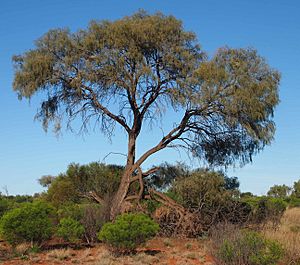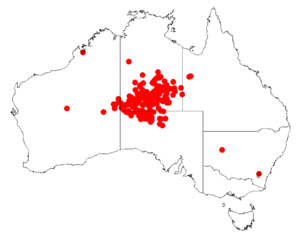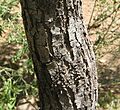Southern ironwood facts for kids
Quick facts for kids Southern ironwood |
|
|---|---|
 |
|
| Scientific classification | |
| Genus: |
Acacia
|
| Species: |
estrophiolata
|
 |
|
| Occurrence data from AVH | |
The Acacia estrophiolata, often called ironwood or southern ironwood, is a special tree. People also know it as desert ironwood or by its Aboriginal name, utjanypa. This tree grows naturally in Central Australia.
Contents
About the Southern Ironwood Tree
The southern ironwood is a beautiful shade tree. It has branches that droop down as it gets older. These trees can grow from 4 to 16 meters (about 13 to 52 feet) tall. Their trunks can be up to 0.45 meters (about 1.5 feet) wide.
When the tree is young, its branches are stiff. It has short, spiky leaves called phyllodes that grow in bunches. As the tree matures, its branches start to droop. The light green spiky leaves get longer and no longer grow in clusters. After winter rains, the tree gets lots of round, pale yellow flowers.
This tree grows slowly. It is very tough and can handle dry weather and cold frosts.
Where Does the Ironwood Grow?
You can find the southern ironwood tree in several parts of Australia. It grows in the northwestern areas of South Australia. It is also found in the southern parts of the Northern Territory. You can see it in the eastern parts of the Pilbara and Goldfields regions of Western Australia.
This tree usually grows in places that get about 220 to 350 millimeters (about 8.7 to 13.8 inches) of rain each year. It likes sandy, well-drained soils. You will often see these trees scattered among tall shrubs and open woodlands.
How People Use the Southern Ironwood
People have used the southern ironwood tree for many things over a long time.
Food and Treats
Long ago, Aboriginal people used the gum from this tree as a sweet treat. They called it Ngkwarle athenge arlperle in the Arrernte language. Some people still eat it today.
To eat the gum, they would snap it off the branches. The gum can be clear or red. Then, they would grind it up and mix it with a little water. After it set again, it became a chewable gum. They would eat it using a small stick.
The seeds of the ironwood tree are also edible. They contain a lot of protein, about 28.9%.
Animal Food
The southern ironwood tree is good food for livestock like cattle.
Traditional Medicine
Different parts of the tree are used in traditional medicine. People use them on the skin to help with burns, cuts, and sores. It can also be used for treating larger wounds. Sometimes, it is made into a lotion to help with eye problems.
Strong Wood
The wood from the southern ironwood tree is very hard. It is great for making strong posts for fences. Indigenous Australians also used this wood to make spears and arrows.
Images for kids



